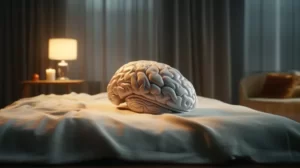Chronic pain and sleeplessness often go hand in hand, creating a vicious cycle that’s difficult to break. When you’re experiencing pain, it’s hard to sleep, and when you’re not sleeping well, it becomes even harder to manage the pain. However, researchers believe that cognitive-behavioral therapy (CBT) could help to conquer both issues simultaneously.
CBT is a form of talk therapy, typically conducted with a therapist, designed to help you become aware of how negative thoughts contribute to challenging situations in your life. This type of therapy is particularly helpful for pain and sleep problems because negative thoughts aggravate both conditions. For instance, if you’re suffering from chronic pain, you might think, “I won’t be able to cope with my pain if I don’t sleep well.” This, in turn, puts more pressure on you to fall asleep and ultimately becomes a self-fulfilling prophecy.
Researchers from the University of Warwick in England recently discovered that people who believe they won’t be able to sleep because of their pain are more likely to suffer from insomnia—and therefore, more severe pain. However, after participating in a short course on CBT for pain and sleep, these individuals were able to eliminate their insomnia and significantly reduce their pain levels.
Dr. Nicole Tang, the study’s senior author, explained the power of thoughts, stating, “Thoughts can have a direct and/or indirect impact on our emotion, behavior, and even physiology. The way we think about sleep and its interaction with pain can influence how we cope with pain and manage sleeplessness.”
If you’re caught in the cycle of pain and sleeplessness, you can visit a therapist to begin CBT, or you can try a few techniques at home first, such as:
Experimenting with different thoughts
One night, try thinking your usual thought (e.g., “I won’t be able to cope with my pain if I don’t sleep well”), and the next night, try flipping it around (e.g., “I’ll cope with my pain just fine, regardless of how I sleep”). Note which night you sleep better.
Challenging the validity of your thoughts
Take a thought (like “I won’t be able to cope with my pain if I don’t sleep well”) and consider the evidence for and against it. For example, you know that not sleeping may make your pain worse, but you also know that you’ve had many nights where you didn’t sleep, and you’ve always managed to cope and get through them. Once you’ve examined the evidence on both sides, create a more balanced thought like, “If I don’t sleep, I’ll be tired. But I’ll manage to get through the day. I always do.”
Scheduling pleasant activities
Write down the next seven days on a piece of paper. Beneath each day, write a specific time when you’ll set aside a few minutes for a pleasant activity. It could be as simple as reading a book or listening to your favorite song. By engaging in activities you enjoy, you’ll create positive emotions that make it easier to think positively in other areas of your life as well.
By incorporating these CBT techniques into your daily routine, you may be able to break free from the cycle of pain and sleeplessness and improve your overall well-being.



